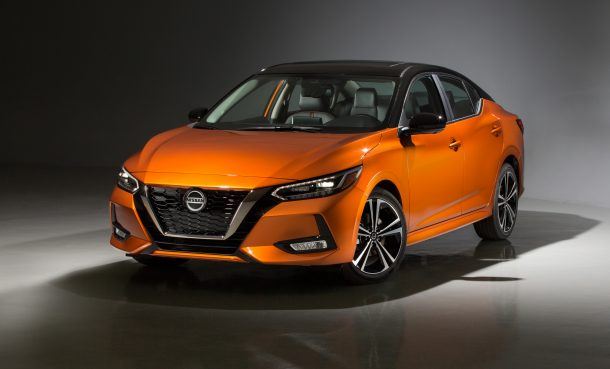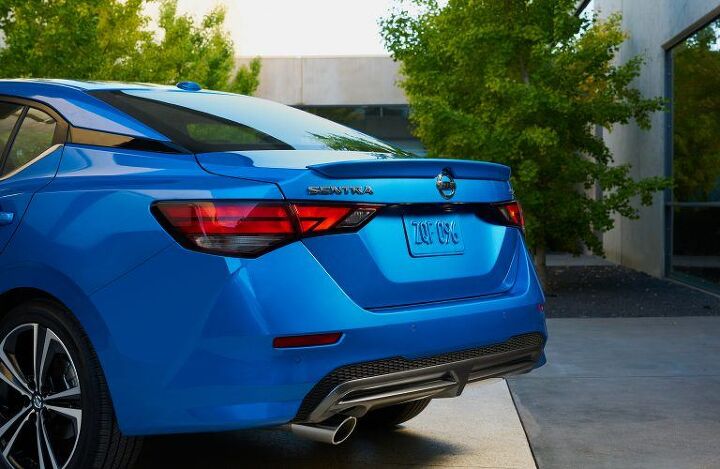Can You See Me Now? 2020 Nissan Sentra Debuts, Prepares to Fight Back Against Honda and Toyota

With America now fully retreated from the compact car space, Japan is left holding the bag in a dwindling market. For two automakers — Honda and Toyota — the abandonment of the compact car market has added wind to slackening sails, but their gain comes at the expense of other players. Nissan is one of those players.
With its next-generation Sentra, Nissan hopes to steal from its rivals’ plates and amass a bigger slice of the pie.
Let’s face it, the current-generation Sentra, while in possession of some serious value, suffers on the styling front — especially when placed alongside the popular Civic and new-for-2020 Corolla sedan. It’s boring to look at, and Nissan doesn’t want you to be bored.
Enter the 2020 Sentra. It’s wider than the last Sentra (by 2 inches) and also lower (by 2.2 inches). Yes, there’s a new platform underneath. It looks a lot like the Maxima, which Nissan bills as a sports sedan, and also like the Altima, which people actually buy. It even looks like the Versa, which underwent its own revamp for 2020. With a signature V-motion grille up front, angular bodysides, slim headlamps, and a floating roof (made all the more apparent in two-tone guise), this Sentra isn’t your buddy’s fiance’s Sentra.
You can order one of three roof combos, by the way.
Nissan claims the upgraded model revealed Tuesday night at the L.A. Auto Show raises the bar in terms in interior refinement and driving dynamics, rather than limboing under it. It’s refined and luxurious, Nissan claims, which are two words seldom applied to a Sentra.
“Extra attention was paid to the smallest of details to improve the perceived and actual quality of the new Sentra,” the automaker said in a statement. “The feel of the steering wheel in the driver’s hands, the smooth operation of the dials and switches were carefully crafted to create a premium feel.”
Premium is another word seldom applied to the Sentra. Of course, there’s a first time for everything, but it will take a spin behind the wheel to determine just how updated this compact sedan really is. By the sounds of it, comfort won’t be too much of a problem, with the company offering quilted, leather-appointed Zero Gravity front heated seats as an available nicety. Upgraded window, door, and body seals add up to a quieter cabin, the automaker promises.
Mercifully, the model arriving for 2020 also sees changes under the hood. Gone is the old Sentra’s 1.8-liter four-cylinder (good for 124 horsepower and 125 lb-ft when paired with a continuously variable automatic, 130 hp/128 lb-ft for six-speed models), replaced by a 2.0-liter unit making a healthier 149 hp and 145 lb-ft. Expect better fuel economy on top of the extra power, Nissan claims.
Unfortunately, the only transmission on offer is a CVT. It’s the latest Xtronic CVT, but still — it’s another death in the manual transmission family. No word on returning turbo NISMO models, either. Given the automaker’s financial problems and ongoing streamlining efforts, it’s not surprising to see reduced build configurations. It seems we’ve retreated to core Sentra.
Indeed, that’s exactly what has happened. For 2020, Sentra buyers will choose from only three trims: S (with hub-capped 16-inch wheels), SV, and SR. Just two options packages exist to temp buyers any further.
Elsewhere, there’s a new steering rack for improved feel, a revamped rear suspension, and standard Nissan Safety Shield 360 driver-assist features to go with existing safety nannies. All told, the safety bundle includes automatic emergency braking with pedestrian detection, blind spot warning, rear cross-traffic alert, lane departure warning, rear automatic braking, high beam assist, forward collision warning, driver alertness monitor, and rear door alert.
Headlights aren’t LED in base and mid-range trim, but the running lights are. LED projector headlamps and LED foglights adorn the SR’s face, and springing for that model also delivers a range of go-fast trappings to the table. Among them, side sills, 18-inch wheels, black side mirrors, black chrome grille, spoiler, and chrome exhaust finisher. That’s “finisher” — singular.
While entry-level Sentras make do with a 7-inch touchscreen and 4.2-inch driver information display, moving up one rung on the food chain brings aboard an 8-inch touchscreen and 7-inch driver’s display, with standard NissanConnect featuring Apple CarPlay and Android Auto connectivity. Base drivers will still get standard Bluetooth hands-free talk and text, Siri Eyes Free, and Google Assistant Voice Recognition.
Adaptive cruise control and an around-view monitor also populate the options list.
Going on sale in January, the 2020 Sentra is quite possibly Nissan’s last chance to retain brand loyalists and create new buyers in the compact space. It’s put together an attractive package, only one that lacks the ridiculous amount of choice offered to Honda buyers. Understandable, given the automaker’s present state.
And maybe Sentra buyers really don’t care about anything but the core product; honestly, when was the last time you saw a Sentra NISMO? The model’s current sales aren’t all that far off the model’s 21st century peak in 2017. We’ll see whether less choice and better product, combined with the brand’s signature value pricing, has the intended effect.
[Images: Nissan, Tim Healey/TTAC]

More by Steph Willems
Latest Car Reviews
Read moreLatest Product Reviews
Read moreRecent Comments
- V8fairy Not scared, but I would be reluctant to put my trust in it. The technology is just not quite there yet
- V8fairy Headlights that switch on/off with the ignition - similar to the requirement that Sweden has- lights must run any time the car is on.Definitely knobs and buttons, touchscreens should only be for navigation and phone mirroring and configuration of non essential items like stereo balance/ fade etc>Bagpipes for following too close.A following distance warning system - I'd be happy to see made mandatory. And bagpipes would be a good choice for this, so hard to put up with!ABS probably should be a mandatory requirementI personally would like to have blind spot monitoring, although should absolutely NOT be mandatory. Is there a blind spot monitoring kit that could be rerofitted to a 1980 Cadillac?
- IBx1 A manual transmission
- Bd2 All these inane posts (often referencing Hyundai, Kia) the past week are by "Anal" who has been using my handle, so just ignore them...
- 3-On-The-Tree I was disappointed that when I bought my 2002 Suzuki GSX1300R that the Europeans put a mandatory speed limiter on it from 197mph down to 186mph for the 2002 year U.S models.








































Comments
Join the conversation
@Vulpine--Those are my concerns with the CVT as well. I don't even care that there is as much acceleration or that it feels different but I do care about wear of the belts and chains and that the fact that the ones Nissan offers cannot be rebuilt but have to be replaced at a cost of 4k to 7k. I don't even care as much if the vehicle has less than 150 hp and I don't expect it to last as long as many of the transmissions. Maybe 100k miles is the most Nissan can get out of the CVTs but then their vehicles should be priced a lot less. If the future is just CVTs and small turbo engines for ICE then I will be ready to switch to EVs. I don't want to pay a lot of money for something that is junk.
That would be acceptable at about $1,200 for a re-manufactured transmission.